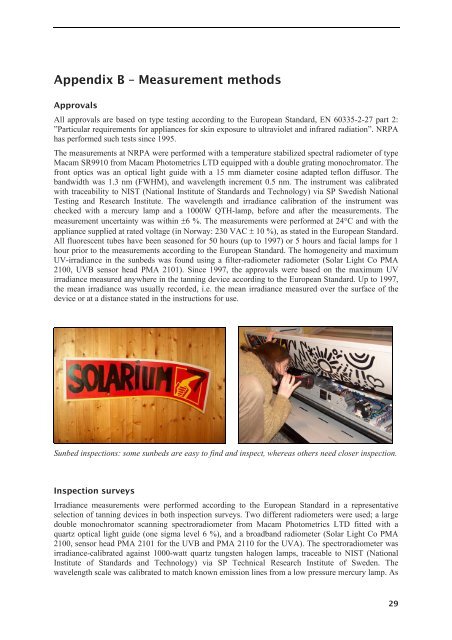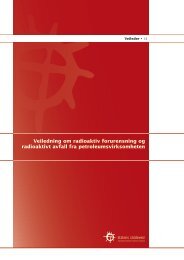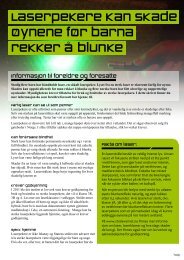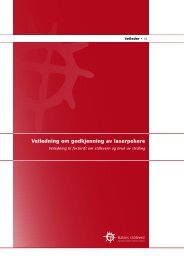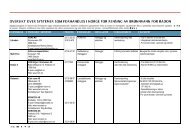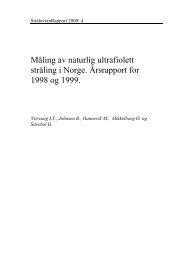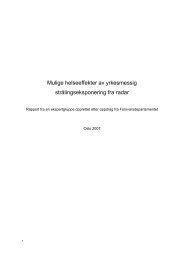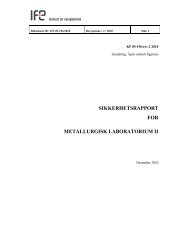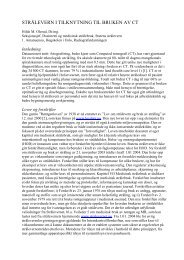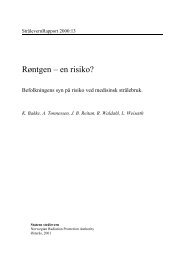Indoor Tanning in Norway - Statens strålevern
Indoor Tanning in Norway - Statens strålevern
Indoor Tanning in Norway - Statens strålevern
Create successful ePaper yourself
Turn your PDF publications into a flip-book with our unique Google optimized e-Paper software.
Appendix B – Measurement methods<br />
Approvals<br />
All approvals are based on type test<strong>in</strong>g accord<strong>in</strong>g to the European Standard, EN 60335-2-27 part 2:<br />
”Particular requirements for appliances for sk<strong>in</strong> exposure to ultraviolet and <strong>in</strong>frared radiation”. NRPA<br />
has performed such tests s<strong>in</strong>ce 1995.<br />
The measurements at NRPA were performed with a temperature stabilized spectral radiometer of type<br />
Macam SR9910 from Macam Photometrics LTD equipped with a double grat<strong>in</strong>g monochromator. The<br />
front optics was an optical light guide with a 15 mm diameter cos<strong>in</strong>e adapted teflon diffusor. The<br />
bandwidth was 1.3 nm (FWHM), and wavelength <strong>in</strong>crement 0.5 nm. The <strong>in</strong>strument was calibrated<br />
with traceability to NIST (National Institute of Standards and Technology) via SP Swedish National<br />
Test<strong>in</strong>g and Research Institute. The wavelength and irradiance calibration of the <strong>in</strong>strument was<br />
checked with a mercury lamp and a 1000W QTH-lamp, before and after the measurements. The<br />
measurement uncerta<strong>in</strong>ty was with<strong>in</strong> ±6 %. The measurements were performed at 24°C and with the<br />
appliance supplied at rated voltage (<strong>in</strong> <strong>Norway</strong>: 230 VAC ± 10 %), as stated <strong>in</strong> the European Standard.<br />
All fluorescent tubes have been seasoned for 50 hours (up to 1997) or 5 hours and facial lamps for 1<br />
hour prior to the measurements accord<strong>in</strong>g to the European Standard. The homogeneity and maximum<br />
UV-irradiance <strong>in</strong> the sunbeds was found us<strong>in</strong>g a filter-radiometer radiometer (Solar Light Co PMA<br />
2100, UVB sensor head PMA 2101). S<strong>in</strong>ce 1997, the approvals were based on the maximum UV<br />
irradiance measured anywhere <strong>in</strong> the tann<strong>in</strong>g device accord<strong>in</strong>g to the European Standard. Up to 1997,<br />
the mean irradiance was usually recorded, i.e. the mean irradiance measured over the surface of the<br />
device or at a distance stated <strong>in</strong> the <strong>in</strong>structions for use.<br />
Sunbed <strong>in</strong>spections: some sunbeds are easy to f<strong>in</strong>d and <strong>in</strong>spect, whereas others need closer <strong>in</strong>spection.<br />
Inspection surveys<br />
Irradiance measurements were performed accord<strong>in</strong>g to the European Standard <strong>in</strong> a representative<br />
selection of tann<strong>in</strong>g devices <strong>in</strong> both <strong>in</strong>spection surveys. Two different radiometers were used; a large<br />
double monochromator scann<strong>in</strong>g spectroradiometer from Macam Photometrics LTD fitted with a<br />
quartz optical light guide (one sigma level 6 %), and a broadband radiometer (Solar Light Co PMA<br />
2100, sensor head PMA 2101 for the UVB and PMA 2110 for the UVA). The spectroradiometer was<br />
irradiance-calibrated aga<strong>in</strong>st 1000-watt quartz tungsten halogen lamps, traceable to NIST (National<br />
Institute of Standards and Technology) via SP Technical Research Institute of Sweden. The<br />
wavelength scale was calibrated to match known emission l<strong>in</strong>es from a low pressure mercury lamp. As<br />
29


